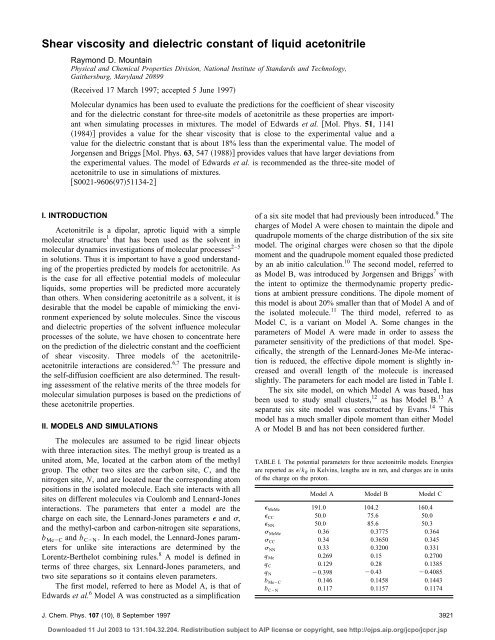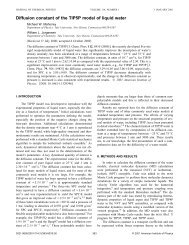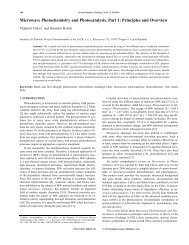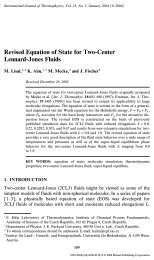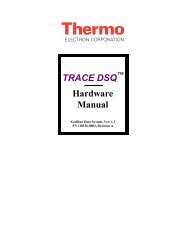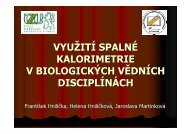Shear viscosity and dielectric constant of liquid acetonitrile
Shear viscosity and dielectric constant of liquid acetonitrile
Shear viscosity and dielectric constant of liquid acetonitrile
Create successful ePaper yourself
Turn your PDF publications into a flip-book with our unique Google optimized e-Paper software.
<strong>Shear</strong> <strong>viscosity</strong> <strong>and</strong> <strong>dielectric</strong> <strong>constant</strong> <strong>of</strong> <strong>liquid</strong> <strong>acetonitrile</strong>Raymond D. MountainPhysical <strong>and</strong> Chemical Properties Division, National Institute <strong>of</strong> St<strong>and</strong>ards <strong>and</strong> Technology,Gaithersburg, Maryl<strong>and</strong> 20899Received 17 March 1997; accepted 5 June 1997Molecular dynamics has been used to evaluate the predictions for the coefficient <strong>of</strong> shear <strong>viscosity</strong><strong>and</strong> for the <strong>dielectric</strong> <strong>constant</strong> for three-site models <strong>of</strong> <strong>acetonitrile</strong> as these properties are importantwhen simulating processes in mixtures. The model <strong>of</strong> Edwards et al. Mol. Phys. 51, 11411984 provides a value for the shear <strong>viscosity</strong> that is close to the experimental value <strong>and</strong> avalue for the <strong>dielectric</strong> <strong>constant</strong> that is about 18% less than the experimental value. The model <strong>of</strong>Jorgensen <strong>and</strong> Briggs Mol. Phys. 63, 547 1988 provides values that have larger deviations fromthe experimental values. The model <strong>of</strong> Edwards et al. is recommended as the three-site model <strong>of</strong><strong>acetonitrile</strong> to use in simulations <strong>of</strong> mixtures.S0021-96069751134-2I. INTRODUCTIONAcetonitrile is a dipolar, aprotic <strong>liquid</strong> with a simplemolecular structure 1 that has been used as the solvent inmolecular dynamics investigations <strong>of</strong> molecular processes 2–5in solutions. Thus it is important to have a good underst<strong>and</strong>ing<strong>of</strong> the properties predicted by models for <strong>acetonitrile</strong>. Asis the case for all effective potential models <strong>of</strong> molecular<strong>liquid</strong>s, some properties will be predicted more accuratelythan others. When considering <strong>acetonitrile</strong> as a solvent, it isdesirable that the model be capable <strong>of</strong> mimicking the environmentexperienced by solute molecules. Since the viscous<strong>and</strong> <strong>dielectric</strong> properties <strong>of</strong> the solvent influence molecularprocesses <strong>of</strong> the solute, we have chosen to concentrate hereon the prediction <strong>of</strong> the <strong>dielectric</strong> <strong>constant</strong> <strong>and</strong> the coefficient<strong>of</strong> shear <strong>viscosity</strong>. Three models <strong>of</strong> the <strong>acetonitrile</strong><strong>acetonitrile</strong>interactions are considered. 6,7 The pressure <strong>and</strong>the self-diffusion coefficient are also determined. The resultingassessment <strong>of</strong> the relative merits <strong>of</strong> the three models formolecular simulation purposes is based on the predictions <strong>of</strong>these <strong>acetonitrile</strong> properties.II. MODELS AND SIMULATIONSThe molecules are assumed to be rigid linear objectswith three interaction sites. The methyl group is treated as aunited atom, Me, located at the carbon atom <strong>of</strong> the methylgroup. The other two sites are the carbon site, C, <strong>and</strong> thenitrogen site, N, <strong>and</strong> are located near the corresponding atompositions in the isolated molecule. Each site interacts with allsites on different molecules via Coulomb <strong>and</strong> Lennard-Jonesinteractions. The parameters that enter a model are thecharge on each site, the Lennard-Jones parameters <strong>and</strong> ,<strong>and</strong> the methyl-carbon <strong>and</strong> carbon-nitrogen site separations,b MeC <strong>and</strong> b CN . In each model, the Lennard-Jones parametersfor unlike site interactions are determined by theLorentz-Berthelot combining rules. 8 A model is defined interms <strong>of</strong> three charges, six Lennard-Jones parameters, <strong>and</strong>two site separations so it contains eleven parameters.The first model, referred to here as Model A, is that <strong>of</strong>Edwards et al. 6 Model A was constructed as a simplification<strong>of</strong> a six site model that had previously been introduced. 9 Thecharges <strong>of</strong> Model A were chosen to maintain the dipole <strong>and</strong>quadrupole moments <strong>of</strong> the charge distribution <strong>of</strong> the six sitemodel. The original charges were chosen so that the dipolemoment <strong>and</strong> the quadrupole moment equaled those predictedby an ab initio calculation. 10 The second model, referred toas Model B, was introduced by Jorgensen <strong>and</strong> Briggs 7 withthe intent to optimize the thermodynamic property predictionsat ambient pressure conditions. The dipole moment <strong>of</strong>this model is about 20% smaller than that <strong>of</strong> Model A <strong>and</strong> <strong>of</strong>the isolated molecule. 11 The third model, referred to asModel C, is a variant on Model A. Some changes in theparameters <strong>of</strong> Model A were made in order to assess theparameter sensitivity <strong>of</strong> the predictions <strong>of</strong> that model. Specifically,the strength <strong>of</strong> the Lennard-Jones Me-Me interactionis reduced, the effective dipole moment is slightly increased<strong>and</strong> overall length <strong>of</strong> the molecule is increasedslightly. The parameters for each model are listed in Table I.The six site model, on which Model A was based, hasbeen used to study small clusters, 12 as has Model B. 13 Aseparate six site model was constructed by Evans. 14 Thismodel has a much smaller dipole moment than either ModelA or Model B <strong>and</strong> has not been considered further.TABLE I. The potential parameters for three <strong>acetonitrile</strong> models. Energiesare reported as /k B in Kelvins, lengths are in nm, <strong>and</strong> charges are in units<strong>of</strong> the charge on the proton.Model A Model B Model C MeMe 191.0 104.2 160.4 CC 50.0 75.6 50.0 NN 50.0 85.6 50.3 MeMe 0.36 0.3775 0.364 CC 0.34 0.3650 0.345 NN 0.33 0.3200 0.331q Me 0.269 0.15 0.2700q C 0.129 0.28 0.1385q N 0.398 0.43 0.4085b MeC 0.146 0.1458 0.1443b CN 0.117 0.1157 0.1174J. Chem. Phys. 107 (10), 8 September 1997 3921Downloaded 11 Jul 2003 to 131.104.32.204. Redistribution subject to AIP license or copyright, see http://ojps.aip.org/jcpo/jcpcr.jsp
3922 Raymond D. Mountain: <strong>Shear</strong> <strong>viscosity</strong> <strong>and</strong> <strong>dielectric</strong> <strong>constant</strong> <strong>of</strong> CH 3 CNFIG. 1. The time evolution <strong>of</strong> S (t) is shown for Model A solid line,Model B long dashed line, <strong>and</strong> Model C short dashed line.The simulations discussed here were performed on a set<strong>of</strong> 216 molecules. Periodic boundary conditions were imposedon a cubic cell <strong>of</strong> fixed volume such that the <strong>liquid</strong>density 15 matched the experimental value <strong>of</strong> 776.7 kg/m 3 at297 K. The temperature was maintained at 297 K using separateNosé-Hoover thermostats 16 for the translational <strong>and</strong> rotationaldegrees <strong>of</strong> freedom. The orientational degrees <strong>of</strong>freedom were described using quaternions. 17The long-range part <strong>of</strong> the Coulomb interactions weredescribed by the Ewald method. 18 As discussed in Ref. 18,the screening parameter was assigned the value 5.6/L,where L is the simulation cube edge length, so that the realspace interactions could be truncated at L/2. The conductingboundary conditions form for the energy was used. TheNosé-Klein form for the long-range part <strong>of</strong> the stress-tensorfor molecules with distributed charges was utilized. 19 Because<strong>of</strong> the very slow convergence <strong>of</strong> the estimate <strong>of</strong> the<strong>dielectric</strong> <strong>constant</strong>, each model was run for a total <strong>of</strong> 800 ps.The equations <strong>of</strong> motion were integrated using an iteratedversion <strong>of</strong> the Beeman algorithm 20 with a time step <strong>of</strong>10 3 ps.The shear <strong>viscosity</strong> was estimated using the time correlationfunction form for the <strong>viscosity</strong>, namely, 21 S lim S t V tt→k B dsPxy sPT xy 0, 10where P xy is an <strong>of</strong>f-diagonal element <strong>of</strong> the molecular stresstensor 19 <strong>and</strong> ••• is an ensemble average <strong>of</strong> the enclosedquantity. For this system, the time correlation function haddecayed to zero within a 10 ps time interval.The <strong>dielectric</strong> <strong>constant</strong> was estimated using the fluctuationexpression appropriate to conducting boundaryconditions 221 4 M 2 3 Vk B T ,2where M is the total dipole moment <strong>of</strong> the sample. The convergence<strong>of</strong> this ensemble average is known to be quite slow.FIG. 2. The value <strong>of</strong> the <strong>dielectric</strong> <strong>constant</strong> as a function <strong>of</strong> the averagingtime for Model A solid line, Model B long dashed line, <strong>and</strong> Model Cshort dashed line.For these systems, the samples were taken over an interval <strong>of</strong>800 ps. This averaging time was found to be sufficient toobtain estimates that have an uncertainty <strong>of</strong> a few percent.Values for the self-diffusion coefficient, D S have beenobtained by determining the long time slope <strong>of</strong> the meansquare displacement <strong>of</strong> molecular centers <strong>of</strong> mass as a function<strong>of</strong> time. Also, the pressure for each model has beendetermined using the molecular virial formulation. 21,23III. RESULTS AND DISCUSSIONThe estimates for the shear <strong>viscosity</strong> were obtained bydetermining the long time behavior <strong>of</strong> S (t). Figure 1 showsthe plots <strong>of</strong> S (t) as a function <strong>of</strong> the correlation time t foreach model. Models A <strong>and</strong> C produce a value on the order <strong>of</strong>3.510 4 Pa•s that is quite close to the experimental value,3.410 4 Pa•s. 15 Model B yields a significantly largervalue for the shear <strong>viscosity</strong>, namely 5.810 4 Pa•s. Thefluctuation <strong>of</strong> the long time values <strong>of</strong> S (t) suggest that theuncertainty in these estimates is on the order <strong>of</strong> 0.210 4 Pa•s.The <strong>dielectric</strong> <strong>constant</strong> is obtained using a similar approach.In Fig. 2 the estimate for the value <strong>of</strong> is shown asa function <strong>of</strong> the averaging time, t. Models A <strong>and</strong> C yield avalue on the order <strong>of</strong> 28, which is somewhat lower than theexperimental value, 36. 15 Model C yields a value for the<strong>dielectric</strong> <strong>constant</strong> that is lower, namely 18. The fluctuationsabout the long time values in Fig. 2 suggest that the uncertaintyin these estimates is on the order <strong>of</strong> 1.The <strong>dielectric</strong> <strong>constant</strong> for Model A was estimated previouslyusing two methods. 6 The first method evaluated thewave vector dependent transverse component <strong>of</strong> the <strong>dielectric</strong>response for small values <strong>of</strong> the wave vector. Thisyielded estimates <strong>of</strong> 273, 285, <strong>and</strong> 333 for thethree smallest wavevectors that were consistent with the periodicboundary conditions. The second method used Eq. 2.Again, an estimate <strong>of</strong> 33 resulted. No error estimate wasreported except to state that the errors were likely to beJ. Chem. Phys., Vol. 107, No. 10, 8 September 1997Downloaded 11 Jul 2003 to 131.104.32.204. Redistribution subject to AIP license or copyright, see http://ojps.aip.org/jcpo/jcpcr.jsp
Raymond D. Mountain: <strong>Shear</strong> <strong>viscosity</strong> <strong>and</strong> <strong>dielectric</strong> <strong>constant</strong> <strong>of</strong> CH 3 CN3923TABLE II. The computed properties for the three models are listed herealong with the experimental values for the pressure, the shear <strong>viscosity</strong>, the<strong>dielectric</strong> <strong>constant</strong> <strong>and</strong> the self-diffusion coefficient. The listed uncertaintiesare described in the text.Model A Model B Model C Experiment S ,10 4 Pa•s 3.50.2 5.80.1 3.50.2 3.4 a 281 181 281 36 ap, MPa 44. 69. 6.0 0.014 bD S ,10 9 m 2 /s 3.55 2.66 3.14 4.3 ca Reference 15.b Reference 26.c Reference 27.larger than for the first method. The duration <strong>of</strong> this simulationwas 67 ps. From the slow rate <strong>of</strong> convergence indicatedin Fig. 2, this is quite likely. A sampling time an order <strong>of</strong>magnitude longer than 67 ps is needed for convergence <strong>of</strong>M 2 . The estimate for reported here for Model A is consistentwith the previously reported estimates.Fixed charge models <strong>of</strong> the type examined here ignoreany induced polarization effects since the dipole moment dueto the fixed charges is quite close to the moment <strong>of</strong> the isolatedmolecule. A separate study <strong>of</strong> the Model A systemprobed the consequences <strong>of</strong> induction effects on the <strong>dielectric</strong><strong>constant</strong>. 24 The result is that induction would increase the<strong>dielectric</strong> <strong>constant</strong> so that the estimate would be closer to theexperimental value. A fully self-consistent simulation <strong>of</strong> inductionwas not made. This would be possible, but time consumingas such studies for other fluids has shown. 25The values <strong>of</strong> the properties for each <strong>of</strong> the models arelisted in Table II. From these simulation results, it appearsthat Model A does a slightly better job <strong>of</strong> reproducing theviscous <strong>and</strong> <strong>dielectric</strong> properties <strong>of</strong> <strong>liquid</strong> <strong>acetonitrile</strong> th<strong>and</strong>oes Model C, <strong>and</strong> both do a significantly better job th<strong>and</strong>oes Model B. Model A provides a value for the selfdiffusioncoefficient that is closer to the experimental valuethan does Model C while the reverse is true for the pressure.The value <strong>of</strong> the self-diffusion coefficient is more significantfor solution simulations than is the value <strong>of</strong> the pressuresince D S measures the mobility <strong>of</strong> the solvent. This indicatesthat the changes made in the model parameters from ModelA to Model C are not useful as they lead to a decrease in theself-diffusion coefficient. For purposes <strong>of</strong> describing a solvent,Model A is the three-site model to use in simulations.1 Y. Marcus, Introduction to Liquid State Chemistry Wiley, New York,1977, pp. 105–109.2 M. Marconelli, J. Chem. Phys. 94, 2084 1991.3 B. M. Ladanyi <strong>and</strong> R. M. Stratt, J. Phys. Chem. 99, 2502 1995.4 B. M. Ladanyi <strong>and</strong> Y. Q. Liang, J. Chem. Phys. 103, 6325 1995.5 B. M. Ladanyi <strong>and</strong> S. Klein, J. Chem. Phys. 105, 1552 1996.6 D. M. F. Edwards, P. A. Madden, <strong>and</strong> I. R. McDonald, Mol. Phys. 51,1141 1984.7 W. L. Jorgensen <strong>and</strong> J. M. Briggs, Mol. Phys. 63, 547 1988.8 J. P. Hansen <strong>and</strong> I. R. McDonald, Theory <strong>of</strong> Simple Liquids Academic,New York, 1986, p. 179.9 H. J. Bohm, I. R. McDonald, <strong>and</strong> P. A. Madden, Mol. Phys. 49, 3471983.10 S. R. Cox <strong>and</strong> D. E. Williams, J. Comput. Chem. 2, 304 1981.11 P. A. Steiner <strong>and</strong> W. Gordy, J. Mol. Spectrosc. 21, 291 1966.12 G. Del Misto <strong>and</strong> A. J. Stace, J. Chem. Phys. 99, 4656 1993.13 D. Wright <strong>and</strong> M. Samy El-Shall, J. Chem. Phys. 100, 3791 1994.14 M. W. Evans, J. Mol. Phys. 25, 149 1983.15 G. P. Cunningham, G. A. Vidulich, <strong>and</strong> R. L. Kay, J. Chem. Eng. Data 12,336 1967.16 G. J. Martyna, M. L. Klein, <strong>and</strong> M. Tuckerman, J. Chem. Phys. 97, 26351992. This paper provides a detailed discussion on the use <strong>of</strong> thermostatsin simulations.17 R. Sonnenschein. J. Comput. Phys. 59, 347 1985; D. C. Rapaport, ibid.60, 306 1985.18 M. J. L. Sangster <strong>and</strong> M. Dixon, Adv. Phys. 25, 247 1976.19 S. Nosé <strong>and</strong> M. L. Klein, Mol. Phys. 50, 1055 1983; see also, D. Brown<strong>and</strong> S. Neyertz, ibid. 84, 577 1995; J. Alej<strong>and</strong>re, D. J. Tildesley, <strong>and</strong> G.A. Chapela, J. Chem. Phys. 102, 4574 1995.20 P. Sch<strong>of</strong>ield, Comput. Phys. Commun. 5, 130 1976.21 S. T. Cui, P. T. Cummings, <strong>and</strong> H. D. Cochran, Mol. Phys. 88, 16571996.22 M. Neumann, O. Steinhauser, <strong>and</strong> G. S. Pawley, Mol. Phys. 52, 971984.23 M. P. Allen <strong>and</strong> D. J. Tildesley, Computer Simulation <strong>of</strong> Liquids Clarendon,Oxford, 1987, pp. 48–49.24 D. F. M. Edwards <strong>and</strong> P. A. Madden, Mol. Phys. 51, 1163 1984.25 R. D. Mountain, J. Chem. Phys. 105, 10 496 1996; addition references tosimulation studies <strong>of</strong> induced polarization are listed here.26 R. W. Gallant, Hydrocarbon Processing 48, 135 1969.27 R. L. Hurle <strong>and</strong> L. A. Woolf, J. Chem. Soc. Faraday Trans. I 78, 22331982; a slightly larger value for the self-diffusion coefficient has beenobtained from neutron scattering data, M. D. Zeidler, Ber. Bunsenges.Phys. Chem. 75, 769 1971.J. Chem. Phys., Vol. 107, No. 10, 8 September 1997Downloaded 11 Jul 2003 to 131.104.32.204. Redistribution subject to AIP license or copyright, see http://ojps.aip.org/jcpo/jcpcr.jsp


